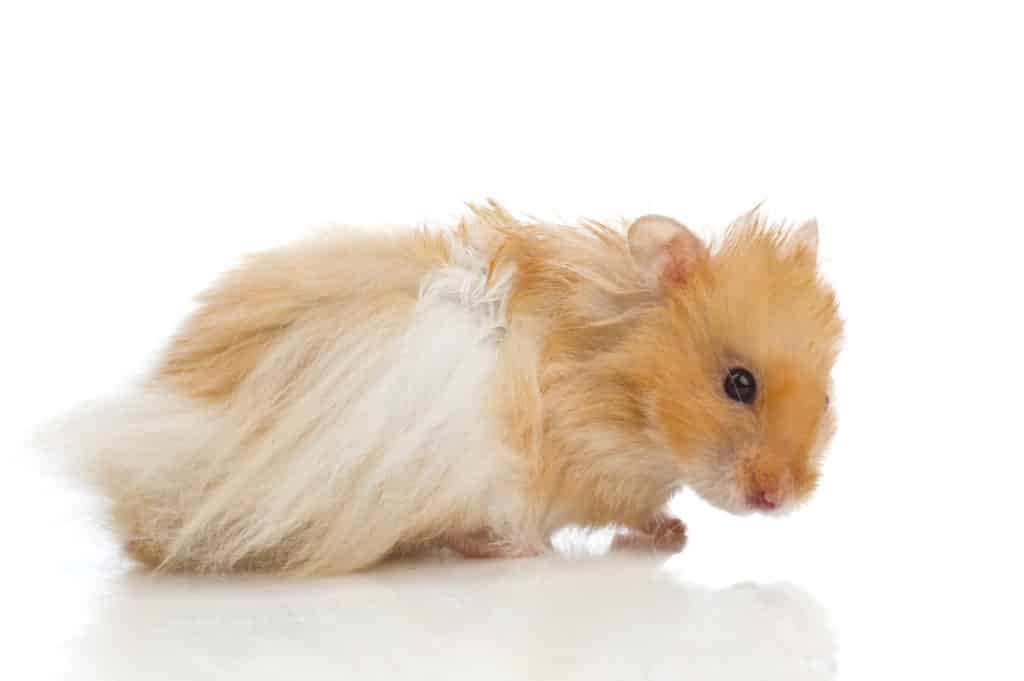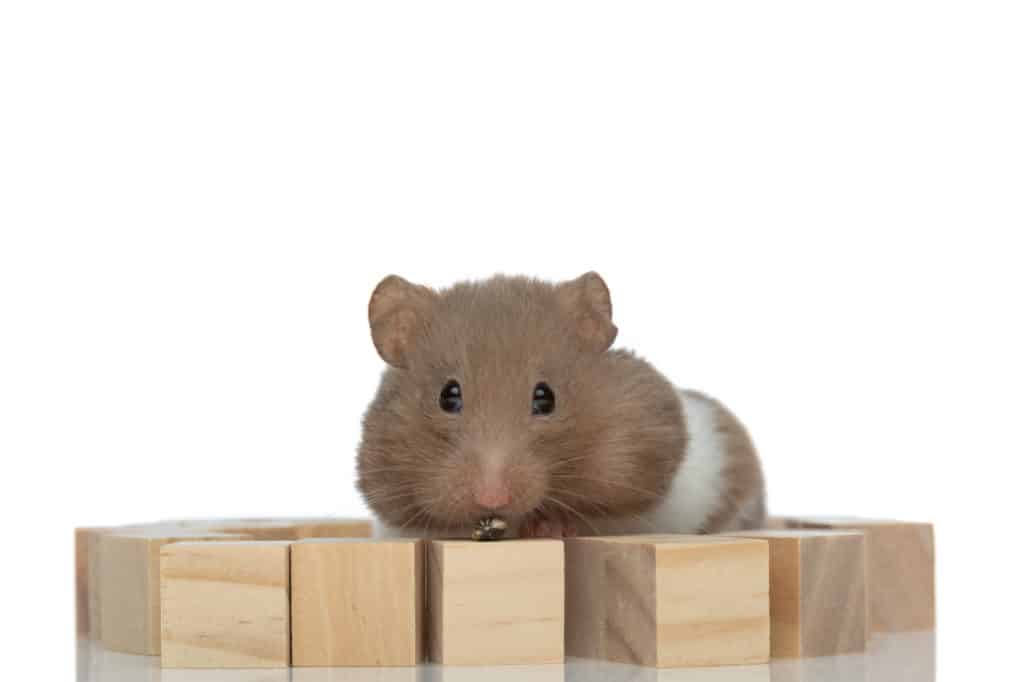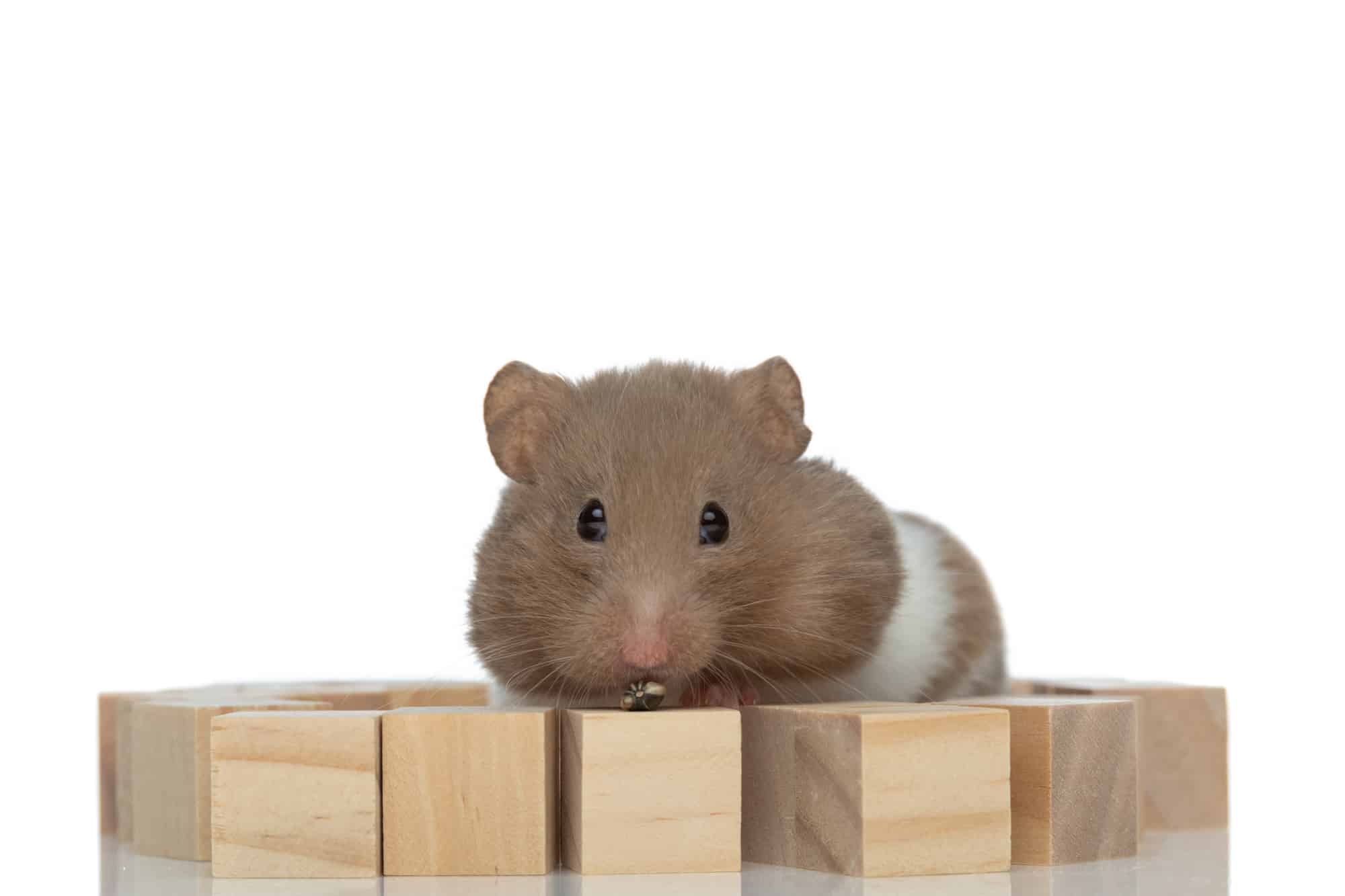Syrian hamsters are the most common type of pet hamsters and also the first hamster breed to be successfully domesticated. Their scientific name is Mesocricetus auratus. They belong to the rodent subfamily Cricetinae.
Syrian hamsters are not only used as pets. They are also often used as laboratory animals to model medical conditions that affect humans, like cancers, cardiovascular diseases, respiratory diseases, etc.
This blog post will help you learn everything you need to know about a Syrian hamster – Their appearance, behavior, diet, sleeping habits, and what you need to do to keep them safe and healthy.
How does a Syrian hamster look?
Size
There is no doubt that Syrian hamsters are cute little creatures. But even though they might appear little to us, they are by no means little in terms of hamster standards. Indeed, they are the largest hamster breed. Adult Syrian hamsters can be between 5 and 9 inches in length and weigh 3.5 to 5.3 ounces. Female hamsters are generally bigger than male hamsters.
Colors
In the wild, Syrian hamsters are mostly golden brown (with ticks of black) in color. But due to cross-breeding, Syrian pet hamsters are available in several additional colors like white, black, grey, brown, lilac, chocolate, cream, golden, etc. (Source: Omlet).
Coat types

Like having different colors, Syrian hamsters can also have different coat types like long-haired, short-haired, satin, and Rex (Source: National Hamster Council, UK). Long-haired Syrian hamsters, as the name indicates, have long fur. Their fur can grow up to 4 inches long. But it is only the male hamsters that develop long fur; the female hamsters generally don’t. The Satin coat Syrian hamsters have fur that looks shiny. The fur and whiskers of Rex coat Syrian hamsters appear as if they have been folded.
Syrian hamsters can also be bred with patterned coats – Dominant Spot, Banded, Tortoiseshell, Tortoiseshell and White, and Roan. The Dominant Spot hamster has patches of color surrounded by a white background. The Banded Syrian hamster can come in different colors. But its most distinguishing feature is that it has a white band or stripe around its middle. The Tortoiseshell hamster has black patches mixed with patches of color. In contrast, the Tortoiseshell and White hamster has white patches in addition to the black patches and patches of color. The coat of a Roan Syrian hamster has white hair mingled with other colors.
Features
Syrian hamsters have large eyes, boat-shaped ears, and a short tail. But just like the other members of the Cricetinae subfamily, the feature that distinguishes them from other rodents is their cheek pouches. Their cheek pouches can expand and extend from their cheeks to their shoulders. It helps them carry the food they find back to their burrows and store them. A Syrian hamster could store up to a ton of food in its lifetime.
Female hamsters can also carry their young in their cheek pouches in times of danger.
If its cheek pouches are too full, the speed of a Syrian hamster will reduce, and its movements may also become restricted.
How was the Syrian hamster domesticated?
We mentioned in the introduction that the Syrian hamster was the first type of hamster to be domesticated successfully. But how was it domesticated? Let’s find out.
Syrian hamsters originate from Syria. That is why they are called Syrian hamsters.
The man who discovered Syrian hamsters was a physician called Alexander Russel. He saw a Syrian hamster in Aleppo, Syria, in 1797 and described it in a journal called The Natural History of Aleppo. But back then, he did not know what to call them. So, he did not give them a name. Almost four decades later (in 1839), a British zoologist by the name of George Robert Waterhouse named these creatures Mesocricetus auratus, meaning golden hair. That is why Syrian hamsters are still called golden hamsters.
However, after George named them, these little creatures went unseen for almost a century.
So, a Jewish biologist called Israel Aharoni, who wanted to make a name for himself by doing something which nobody had done before and thought that hamsters could make excellent laboratory animals for researching a cure for a common disease at that time, decided to find and domesticate Syrian hamsters. So, despite his reluctance to travel, he went to Aleppo, Syria, on the mission to find Syrian hamsters.
With the help of a local hunter, he went door to door, asking people if they had seen a Syrian hamster nearby. After several days of knocking on doors, they hit the jackpot. Some people had seen a Syrian hamster on a farm nearby. So, they went there and started digging. After digging eight feet, they found what they were looking for – a female Syrian hamster and her 11 babies. Now all that was left for Israel to do was to take these hamsters back to his lab and somehow get them to breed. So, he put them all in a box.
However, once they were inside the box, the mother hamster, probably stressed, ate one of her own babies. So, Israel killed her and took the remaining 10 pups to his lab in Jerusalem. While transportation, one of the remaining pups escaped, and five more escaped when they were in his lab in Jerusalem. Finally, Israel was left with just 4 Syrian hamsters – one male and three females. But the male killed and ate one of the females. So, Israel separated the hamsters and kept them in separate enclosures.
Then, he reintroduced one of the females to the male. Once the female and the male saw each other after the period of separation, they started to mate.
That single brother-sister pair made 150 babies. Those babies grew up and made even more babies.
Today, Syrian pet hamsters are found worldwide in millions of homes. Even though other wild Syrian hamsters were captured and sent to labs following Israel’s successful adventure, the ancestors of almost all the pet Syrian hamsters today are the single brother-sister duo that Israel got to mate in the 1930s.
Behavior
Social behavior
Syrian hamsters are strictly solitary and fiercely territorial animals. They only ever come together for mating. Even then, female hamsters can become aggressive against male hamsters if they stay back for long after mating. This usually ends up with the female hamster killing the male hamster.
So, you cannot put two Syrian hamsters in a single cage. If you do, they will constantly fight each other until one of them dies. You can’t even keep them in separate cages in the same room because they will be able to smell each other. So, they would want to fight each other. But since they cannot do that, they will be stressed all the time, and it will affect their health. So, if you have more than one Syrian hamster, you should keep them in separate cages in different rooms.
But even though Syrian hamsters hate one another, they can quickly get accustomed to the human touch. So, they can be easily tamed. Once they are tamed, they like to be held by humans. They are the hamster species that is best for beginners. They are one of the very few hamster species that are suitable to be handled by children as well. But even though they can be handled by children, the children should be at least six years old, and they should always be supervised.
Once tamed, Syrian hamsters can become quite attached to you and will need a lot of your attention. If you are not able to provide that attention, they will get bored and stressed. If your hamster starts biting the cage bars or starts climbing them, it is a definitive sign that your hamster is bored. So, you should keep a good number of hamster toys in your hamster’s cage. That way, he won’t get bored even if you are not able to spend sufficient time with him.
Diet

The digestive systems of Syrian hamsters are more tolerant than other breeds of hamsters. So, they can eat a wide range of foods when compared to other hamster species (particularly dwarf hamsters). Eating a little bit of sugary and acidic food items won’t make them diabetic or obese or give them diarrhea. So, you have greater freedom in deciding which food items to include in their diet.
The diet of a Syrian hamster should consist of 7-13% protein, 6-8% fiber, and 4-5% fat (Source: Wikipedia). It must also include Vitamin E, which is an excellent antioxidant. The best food for Syrian hamsters is the commercially available hamster pellets. But they should not be fed alone. A mixture of pellets, seeds, fruits, and vegetables works best.
But even though Syrian hamsters have a more tolerant digestive system when compared to other hamster species, not all fruits and vegetables are safe for them. For example, they must not be fed citrus vegetables or fruits. Also, avoid food items with high sugar or fat content. Moreover, caffeine and sticky items like chocolate that can stick to your Syrian hamster’s cheek pouches are a big ‘NO’ as well.
Now that we have seen what Syrian hamsters should not eat let’s find out what they can eat.
Carrots, cucumber, celery, lettuce (except iceberg lettuce), and kale are some of the vegetables that Syrian hamsters can eat. Apples, strawberries, pears, and bananas are some fruits that are safe for them to eat. Nuts and seeds are also safe and healthy for them to eat.
But what you should also remember is that, just like which food you give your hamster matters, it also matters how you give it to them. When it comes to fresh vegetables and fruits, it’s important that you buy those that are organically grown. Fresh vegetables and fruits that are available in the supermarket are, most probably, not fresh. Pesticides are often sprayed onto them to keep pests away from them. Moreover, fruits are often plucked before they ripen, and chemicals are sprayed onto them during transportation to artificially ripen them. If your hamster consumes these chemicals, it will be harmful to him in the long run.
But if you do end up buying vegetables and fruits from the supermarket, you should wash the vegetables and fruits thoroughly. Only then can you give it to your hamster.
You should also remove any uneaten pieces of fruits and vegetables from your hamster’s cage within 24 hours before they rot and become a breeding ground for harmful pathogens.
Sleeping habits
Syrian hamsters are highly crepuscular animals. They are more active at dusk and dawn than during the day or night. And you cannot wake them up while they are sleeping either, because it will make them get stressed and affect their health. However, if you have a day job, they will be awake by the time you return home. So, you don’t have to change your lifestyle much to spend time with them.
Keeping a Syrian hamster as a pet
Pet Syrian hamsters can live for 2 to 3 years when cared for properly. Caring for a Syrian hamster properly means that you provide him nutritious food, create the right living conditions (a room that is not noisy or smelly), and engage with him regularly. If not, he might become sick, stressed, or depressed. Also, you should remember that Syrian hamsters live (in the wild) in arid areas. So, the right room temperature for a Syrian hamster is 18 – 24°C.
A Syrian hamster can run two to five miles every day. So, he can be pretty active. Add it to the fact that Syrian hamsters are the largest breed of hamsters, and you will understand that he needs a larger cage when compared to other smaller breeds of hamsters. For your Syrian hamster to be happy and not be depressed, his cage should be large enough to sustain his daily activity like in the wild. So, you should aim for a cage that has a floor space of 620 sq. inches (E.g., 31″ x 20″). In addition to that, the cage should also be able to accommodate bedding that is at least 12″ thick. Your hamster should also have a lot of toys to play with so that he doesn’t get bored easily.
A hamster ball (and a hamster wheel) is an important play tool for a hamster. Without it, your hamster can get bored pretty easily. The hamster ball (or wheel) for Syrian hamsters should have a diameter of at least 12″ (Source: Wikipedia). Smaller hamster balls can lead to spinal curvatures and back pain, especially for younger Syrian hamsters. So, make sure that you get the right-sized ball for your hamster.
A Syrian hamster’s life cycle
As previously mentioned, Syrian hamsters are solitary creatures. A male and a female get together only to mate. And after mating, the female hamster usually drives the male away.
A female Syrian hamster comes into heat once every four or five days. During this time, she will be ready to mate. This is the only time she will allow a male hamster to get near her. If she mates during this time, there is a high chance of her becoming pregnant.
Once the female becomes pregnant, the pups are born in 16 days (Source: Towyvale).
One thing you should know is that, from the time when your Syrian hamster gets pregnant up until the time her pups have completely weaned off, you should not try to hold her or her babies or change her cage too much. Indeed, you shouldn’t disturb her at all. This is the time when she can get stressed easily. And if she gets stressed, she might eat her pups. For the same reason, you shouldn’t try to touch or hold her pups because, then, your scent will stick to the pups, and she won’t recognize her pups. She might consider her own pups as foreign threats and might eat them. So, you should leave the mother and her pups alone at least until the pups are fully weaned off.
But you should keep enough food for your Syrian hamster so that she can regain her health after childbirth (Source: First hamster). Protein, in the form of egg whites and small pieces of cooked chicken, is vital during this time.
Syrian hamsters can give birth to 8 to 10 pups at a time. The pups are born blind and naked, i.e., without any fur. They survive by drinking their mother’s milk.
When they are three weeks old, the pups can start eating solid foods. You will also find the pups occasionally eating the droppings of adult hamsters (Source: Chewy). This is a completely normal and necessary habit that helps young hamsters survive. The droppings of adult hamsters contain bacteria that the pups need to break down the cellulose (hard cell walls of plant products like vegetables) in the food they eat. So, you don’t have to worry about it.
When they are four weeks old, Syrian hamsters are fully weaned off.
By this time, they also become sexually mature. So, by this time, you should separate the male Syrian hamsters from their mother and sisters. If not, they can mate and produce pups that you may not be ready to take care of. So, you should separate them before they turn four weeks old.
But even though Syrian hamsters reach sexual maturity when they are four weeks old, they don’t become full adults, i.e., reach their full size until they are 12 weeks old.
Diseases and medical conditions
- The condition that most hamster species are prone to, is diarrhea. Diarrhea can be caused if your hamster overeats food items that contain a lot of water. A high fiber intake can also cause diarrhea. Diarrhea might also be caused by bacteria (Source: MSD Manual). Diarrhea can quickly lead to a condition called the Wet Tail. Symptoms of this condition include a wet tail with pieces of feces sticking to it, dehydration, and loss of appetite. Wet Tail can lead to sudden death. So, if any of these symptoms occur, you should take your hamster to a vet without delay.
- Syrian hamsters can have a lot of fur. So, they are often prone to mite infestations. Mite infestation makes their skin itchy, making them scratch their bodies against objects and lose their fur. If you see bald patches on your hamster’s fur, it might be because of a mite infestation. A vet can scrape the skin of your hamster and use it to diagnose the problem. So, take your hamster to a veterinary doctor if you see such symptoms.
- If your hamster hurts himself and cuts his skin, pus could form under his skin (Source: The Spruce Pet). This would eventually become a noticeable lump as the pus accumulates. This lump, called an Abscess, would normally drain on its own. The body part that is most prone to Abscesses is the hamster’s cheek pouch. If you feed your hamster a food item that has sharp edges, it could hurt your hamster’s cheek pouches. It could cause a cut in the skin and lead to the formation of an Abscess. If your hamster’s cheek pouch looks like it is loaded with food all the time, there might be an Abscess inside its mouth. If that’s the case, you should take your hamster to a veterinary doctor. He can drain the pus and treat the Abscess with antibiotics.
- Unlike a human, a hamster’s teeth keep growing until he dies. So, he must wear them out constantly. If not, his teeth might become too big and prevent him from eating properly, causing nutritional deficiencies and making him lose weight. In extreme cases, his teeth might even grow into his nasal cavity or skull. There are toys available in pet shops to help your hamster wear his teeth out. You can buy these and keep them in your hamster’s cage. But if your hamster doesn’t wear his teeth out despite having these toys, take him to a veterinary doctor. The doctor can trim his teeth.
Even if your hamster doesn’t show any of these symptoms, you should still take him to the vet for regular health check-ups.



